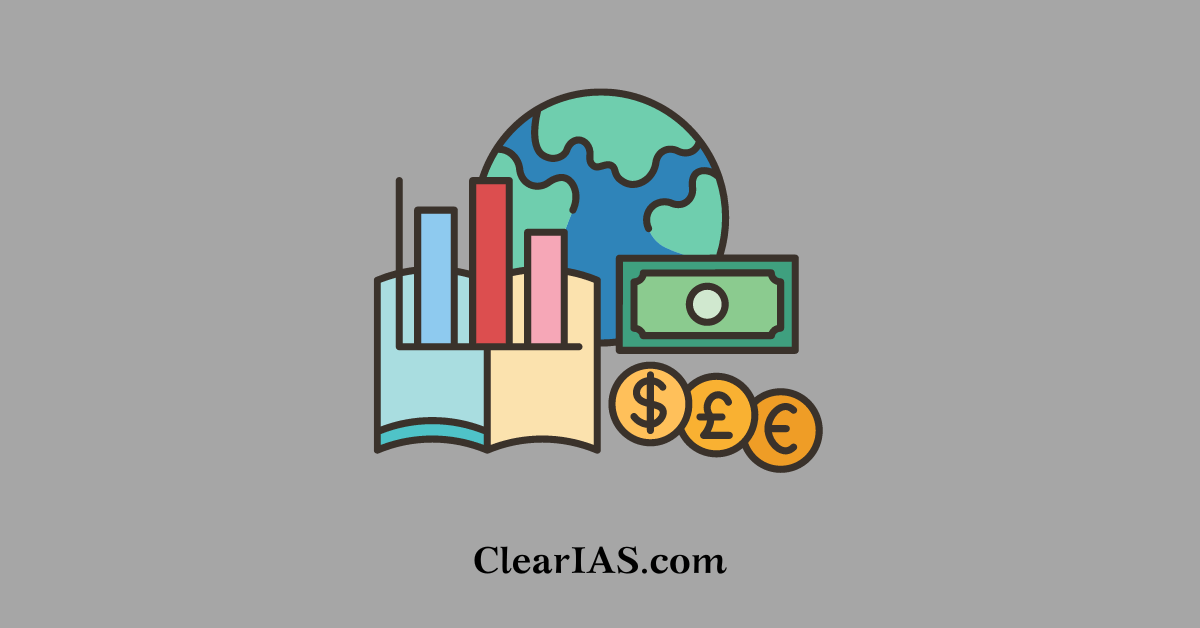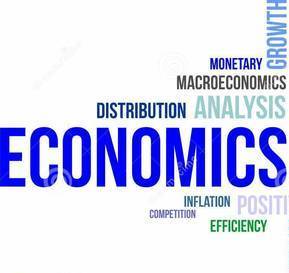 Economics is a tough nut to crack for many – GDP, GNP, NDP, NNP, Repo, Reverse Repo, SLR, CLR, CRAR – there are many concepts to be understood. But if the concepts are properly understood economics is fun.
Economics is a tough nut to crack for many – GDP, GNP, NDP, NNP, Repo, Reverse Repo, SLR, CLR, CRAR – there are many concepts to be understood. But if the concepts are properly understood economics is fun.
ClearIAS.com is trying to provide an overview of the basic concepts of Economics in a simple language for easy understanding.
What is Economics?
Economics is the study of how society allocates scarce resources (land, labour, capital, and entrepreneurship) to produce output (goods and services).
What is the main objective of any economy?
Production of goods and services.
3 Basic Economic Activities in an Economy
- Production
- Consumption
- Capital Formation (ie Saving and Investment)
What are the factors of production?
Factors of production are those inputs used in the production process to produce the outputs (finished goods and services).
There are mainly four factors of production. They are (1) Land (2) Labour (3) Physical Capital and (4) Human Capital.
Why is production low in many economies?
Goods and services are scarce because the four factors of production (land, labour, capital, and entrepreneurship) are scarce.
Basic Concepts of the Indian Economy
The main areas covered in this article are – national income, monetary policy, fiscal policy, and balance of payments(BoP).
Also read: Dollarization of Economy
National Income
Under the broad topic of national income, you may hear terms like GDP, GNP, NNP etc.
GDP: Gross Domestic Product (GDP) is the total money value of final goods and services produced in the economic territories of a country in a given year.
GDP stands for the total value of goods and services produced inside the territory of India irrespective of whom produced it – whether by Indians or foreigners.
To give an approximate idea, let’s assume the total value of goods and services produced in India to be around 100 lakh crore Indian rupees or around 2 trillion US dollars.
This is the value of Indian GDP when expressed at the current market price.
GNP: Gross National Product (GNP) is the total value of goods and services produced by the people of a country in a given year.
It is not territory specific.
If we consider the GNP of India, it can be seen that GNP is lesser than GDP.
Also, see Indian Economy: Issues Related to Planning.

Monetary Policy
Monetary Policy refers to the policy of the central bank. India Reserve Bank of India (RBI) is responsible for monetary policy. Repo, Reverse Repo, CRR, SLR etc are part of monetary policy.
REPO rate
REPO means Re Purchase Option – the rate by which RBI gives loans to other banks. Bank re-purchases the securities deposited with RBI at the REPO rate.
Let’s assume that the current REPO rate is 4.5%. This means RBI gives loans to other banks at a 4.5% interest rate.
Reverse REPO rate
RBI at times borrows from banks at a rate lower than the REPO rate, and that rate is known as the Reverse REPO rate.
Let’s assume that the current Reverse REPO rate is 4%. This means banks give loans to RBI at a 4% interest rate.
REPO and Reverse Repo are two major options under LAF (Liquidity Adjustment Facility).
Also see: REPO and CRR Rate Cuts – What Should You Understand?
Marginal Standing Facility (MSF)
MSF is the rate at which scheduled commercial banks could borrow money overnight from RBI against approved securities.
The borrowing limit of banks under the marginal standing facility is 2 per cent of their respective Net Demand and Time Liabilities (NDTL).
Let’s assume the current MSF Rate is 5.5%. This means commercials banks can borrow money from RBI overnight equal to 2% of their deposits at a 5.5% interest rate. You may note that MSF rate is usually higher than the REPO rate.
Bank Rate
The bank rate is a higher rate, (usually 1% higher than the REPO rate) charged by RBI when it gives loans to commercial banks.
To get a figure, let’s assume the present bank rate is 5.5 %. This is higher than the REPO rate of 4.5%. However, you may wonder how Bank Rate is different from MSF.
The Bank rate is different from MSF in the nature that the Bank rate is long term. It applies to all commercial banks and there is no limitation like 2 per cent of their respective Net Demand and Time Liabilities (NDTL).
Also read: Effects of Liberalization on the Indian Economy
CRR
CRR corresponds to Cash Reserve Ratio.
It corresponds to the percentage of liquid reserves each bank have to keep as cash reserve with RBI (in their current accounts) corresponding to the deposits they have.
Banks will not get any interest for these deposits.
To get a mental picture, let’s assume the present CRR is 3%.
SLR
SLR (Statutory Liquidity Ratio) corresponds to the percentage of liquid reserves each bank have to keep as cash reserve with themselves corresponding to the deposits they have.
Banks have to mandatory keep reserves corresponding to SLR locked with themselves in the form of gold or government securities.
Let’s assume the present SLR is 18.5 %.
The main difference between CRR and SLR is that banks need to keep CRR with RBI, but SLR with themselves, but locked.
CRAR
Capital to Risk-Weighted Assets Ratio is arrived at by dividing the capital of the bank by aggregated risk-weighted assets.
The higher the CRAR of a bank the better capitalized it is.
Fiscal Policy
Fiscal policy refers to the policy actions of the Government. Budget, tax, subsidies, expenditure etc. form part of the fiscal policy. You might need to understand various deficits like Fiscal Deficit and Primary Deficit as part of Fiscal Policy.
Fiscal Deficit (FD): The fiscal deficit is the difference between the government’s total expenditure and its total receipts (excluding borrowing). In layman’s terms, FD corresponds to borrowings and other liabilities.
Balance of Payments
Current Account Deficit (CAD): Current Account is the sum of the balance of trade (exports minus imports of goods and services), net factor income (such as interest and dividends) and net transfer payments (such as foreign aid). The current account deficit in simple terms is dollars flowing in minus dollars flowing out.
Also, see Fiscal Deficit and Current Account Deficit.
Capital Account Deficit: Capital account Deficit occurs when payments made by a country for purchasing foreign assets exceed payments received by that country for selling domestic assets. (For example, if Indians are buying a lot of properties in the US, but if Americans are not buying any properties or buildings in India, India will have a Capital Account Deficit.)
A deficit in the capital account means money is flowing out of the country, but it also suggests the nation is increasing its claims on foreign assets. In other words at times of Capital Account Deficit, foreign investment in domestic assets is less and investment by the domestic economy in foreign assets is more. If you need to know more about BoP, refer to our notes on Balance of Payments.
Tip: For more free notes on economics, browse our economics archive.






Complicated explained easily……
Well explained, thanks
nice…plz update current values
very well explained. thanks!
very much usefull…
Great website for aspirants…great job
@Gyanranjan: Thanks.
Happy to see this notes which is simplified
sir what is the procedure to apply for upsc pre 2016? and when will the forms be available at the book stores and vendors?
thankyou
Sir upsc prelims admission form is not available at samalkha book stores. Kindly guide how to apply for upsc prelims 2016?
Well elaborated ….thanks …….
Hindi language mai muje chaiye sir plzz
i really like your articles that seem a great effort by ClearIas team …thank you so much and keep it Alive!!!
thanks clear ias that you providing notes in very easy language that anyone understand . . . . .keep it going . .. . you are helping many indeed .
I m highly thankful to ur team. It benefits a lot
it is too much essential site for those candidates who prepare upsc xm by net site
How could i download these notes as PDF.
Very clear concepts . plz sir you have to describe in Hindi language.
Great great great ! Excellence site to gain knowledge about everything..Don’t miss friends.
Bhai aap economy ki useful term explain kar skte ho kya… jo aksar use hoti hai
Thanks
Kindly update the info.
Very helpful concept of economics.Thank you sir
this explanation just creates more questions in mind. who do I ask ?
Good that you have more questions. That’s a positive sign of learning. Feel free to ask your questions in the comment section below. Either someone from our team OR your fellow aspirants who prepare for UPSC exam will help you clear your doubts.
How can I subscribe u ..??
Sir hindi main notes mil Skte hain kya????
Amazing, this made me feel like flying bcz my phobia “economy ” became really joyfull with these terms.thank you clearias
Basics are very very good to learn and to understand easily thank you
Very well explained, thank u
very well explained
Are the products made in India in which the intermediate products are from foreign are included in GDP of India ????????
This website is very good for prep
Thank u sir for making complex topic simple
2 lakh crore Indian rupee …how equals to 2 trillion us dollar. .1 dollars. .approx 70 rs
alex sir mock text series ulla print materials nalkamo
Good Sir
very much useful
very much useful for me
Please sir basis concept of Indian economic very short me batadijia
really helpful, I’m grateful to you
It’s very simple to understand and very much useful too….Thank you very much ClearIAS….
Such a great article. This helps me a lot. It’s very informative. And once again thank you so much. getuplearn